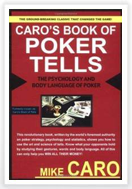 |
Author: Mike Caro Publisher: Cardoza Pages: 320 Pub. Date: March 2003 Price: $16.47 |
Book Review
Mike Caro has been one of the leading poker players in the world for many years. He has the nickname of “The Mad Professor,” not just because of his different and inventive theories on the game, but because of his virtually disheveled look, with a scraggly beard and a suit that doesn’t necessarily look recently pressed. His specialty has been in games not as popular as they used to be, specifically draw poker. In seven card stud, unlike hold ’em or Omaha, players have some cards showing and the possibilities are more varied. That game, still played at the world championships, was the favorite of a previous generation, but due to the overwhelming interest in Texas hold ’em, it has less popularity today and is not available in many casinos. However, in his book, “Caro’s book of Poker Tells: The Psychology And Body Language of Poker,” Mike Caro has advice and information useful for all variations of the game.
Caro gives dozens of examples of “tells,” those tips players reveal with their appearances or actions which can give away their hand. Caro includes well over 100 photos. Unfortunately, they are in black and white and not photographed with anything close to modern digital technology, but these photos do show what he is talking about. They examine such matters as the way a player taps his fingers or how he stacks his chips. A tight player, he says, stacks his chips neatly, a loose player just the opposite.
Equally important in Mike Caro’s book is his discussion of the psychology of players. He says your opponents usually try to fool you by acting weak or uncertain when they’ve actually got a strong hand. If they’re bluffing, they often show a great deal of confidence hoping to fool you. Caro goes into great detail about tells, both physical and psychological, for each stage of the hand.
Caro’s information is very useful to players in two ways. Not only does it give insights into what other players are doing at the table, it also lets you know what to look for and avoid in your own actions. For example, if you were rushing the chips into the pot, or throwing them in, those tells you are giving away to your opponents.
Caro also gives some good general advice, such as his instruction not to watch the flop, but to look at the other players while they are watching the flop. Usually, they will give away more information at that point than at any other time of the hand. If they look away, Caro says, this means they have a strong hand. If they keep staring at the cards, they likely are weak. After you’ve observed all these important tells, you can then look at the cards yourself. This is just one of the many insights Caro makes in his book, an invaluable source of information for all poker players.